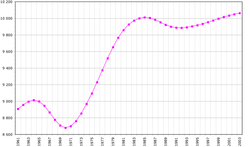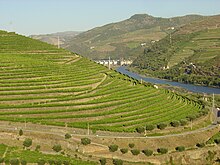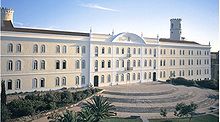Economy of Portugal
The government that assumed office in June 2011 had to face tough choices in regard to its attempts to stimulate the economy while at the same time seeking to maintain its public deficit around the EU average.[45] During the Portuguese Empire period, started in the 15th century, until the Carnation Revolution of 1974, the economy of Portugal was centered in trade and raw materials related activities within its vast colonial possessions, mainly in Asia (spices, silk, dyes, porcelain and gems), Africa (ivory, timber, oil, diamonds and slaves) and South America (sugar cane, dyes, woods, and gold).The regime maintained a policy of corporatism that resulted in the placement of a large part of the Portuguese economy in the hands of a number of strong conglomerates, of which, the most important were known as the "seven magnificent".[46] Other medium-sized family companies specialized in textiles (for instance those located in the city of Covilhã and the northwest), ceramics, porcelain, glass and crystal (like those of Alcobaça, Caldas da Rainha and Marinha Grande), engineered wood (like SONAE near Porto), canned fish (like those of Algarve and the northwest which included one of the oldest canned fish companies in continuous operation in the world), fishing, food and beverage producing, tourism (well established in Estoril/Cascais/Sintra (the Portuguese Riviera) and growing as an international attraction in the Algarve since the 1960s) and in agriculture and agribusiness (like the ones scattered around Ribatejo and Alentejo – known as the breadbasket of Portugal, as well as the notorious Cachão Agroindustrial Complex[47] established in Mirandela, Northern Portugal, in 1963) completed the panorama of the national economy by the early 1970s.However, in a context of an expanding economy, bringing better living conditions for the Portuguese population in the 1960s, the outbreak of the colonial wars in Africa set off significant social changes, among them the rapid incorporation of more and more women into the labour market.This was amplified by the mass emigration of skilled workers and entrepreneurs due to political intimidation, and the costs of accommodating in Portugal thousands of refugees from the former overseas provinces in Africa – the retornados.The Portuguese economy had changed significantly by 1973 prior to the leftist military coup, compared with its position in 1961 – total output (GDP at factor cost) had grown by 120 percent in real terms.After the Carnation Revolution military coup of 1974, by abandoning its moderate-reformist, pro-democracy posture, the Movimento das Forças Armadas leadership set out on a course of sweeping nationalizations and land expropriations during a period known as PREC.By contrast, in the early 1970s (before the 1974 military coup), Portugal's export list reflected significant product diversification, including both consumer and capital goods.Among the most notable Portugal-based global companies are SONAE, Amorim, Sogrape, EFACEC, Portugal Telecom, Jerónimo Martins, Cimpor, Unicer, Millennium bcp, Lactogal, Sumol + Compal, Delta Cafés, Derovo, Critical Software, Galp Energia, EDP, Grupo José de Mello, Sovena Group, Valouro, Renova, Teixeira Duarte, Soares da Costa, Portucel Soporcel, Simoldes, Iberomoldes, Logoplaste and TAP Portugal The Portuguese Financial crisis was a major political and economic crisis, related with the European sovereign debt crisis and its heavy impact in Portugal.Consequently, numerous ineffective external consultancy/advising committees and firms were funded, and this facilitated considerable slippage in state-managed public works, inflated top management and head officers' bonuses and wages.Apparently, Prime Minister Sócrates's cabinet was unable to forecast or prevent the crisis when symptoms first appeared in 2005, and was later incapable of doing anything to ameliorate the situation when the country was on the verge of bankruptcy in 2011.Some senior German policymakers publicly stated that emergency bailouts for Greece and future EU aid recipients should be accompanied by harsh penalties, which caused social unrest in Ireland and across Southern European countries, germanophobia, a big increase of euroscepticism and the rise of far-left and far-right parties in Greece (namely SYRIZA, Golden Dawn, among others), as well as the eurosceptic Five Star Movement and Lega Nord in Italy.At the time the Portuguese government reaffirmed its commitment to continue its economic reform, declaring that while the bailout had allowed the country to put its economy back on track, it still faced significant challenges.[37] The International Monetary Fund issued an update report in late June 2017 with some positive news including a stronger near-term outlook and an increase in investments and exports.[82][83] By 2022, the Portuguese productivity of labour had fallen to the fourth lowest position among the 27 member-states of the European Union with only Bulgaria and Greece being clearly inferior to Portugal in that parameter.It is also worthy to mention the item "public order and safety" and "defence", with the compensations to employees and intermediate and final consumptions being quite higher than the EU average.The increase of the number of people that emigrated to work in other countries also impacted positively the reduction of the unemployment, this happening specially in 2013, when the labor force decreased 1.6% in the first 9 months of the year.Maria da Conceição Cerdeira, one of the authors of a published research study made by the Lisbon School of Economics and Management (ISEG), explained that "in a generic way, there is not a high intensity of work, or a great psychological pressure" in Portugal, for the mass of common ordinary workers, unlike what happens in Northern Europe or North America.[105] A study conducted by Harvard Business School, including 9 EU member-countries, also revealed that Portugal had the 2nd worst managers in that universe, just above Greece, and below Ireland, Poland, Italy, UK, France, Germany and Sweden.This was directly correlated with a general lack of employability and a student's under-preparation for the workplace that was seen among many courses in a number of fields that were offered by certain higher education institutions or departments.The implementation of the Bologna process and other educational reforms, such as the compulsory closing of a number of courses, departments, colleges and private universities after 2005 due to a lack of academic rigour and low teaching standards, was a completely new approach to tackle the problem.The European economic crisis has increased the number of households that remain below the poverty line in Portugal with the greatest affected being the youth due to high unemployment rates.[118] The minimum wage policy is aimed at reducing abject poverty and income inequalities in Portugal which will increase demand and lead to economic stability in the long-term.This report shows GMI policy measures as effective in eradicating poverty and increasing income equality in Portugal[124] The tertiary sector is presently the most important component of the Portuguese economy, representing 75.8% of the gross value added (GVA) and employing 68.1% of the working population.Their physical output is low but reasonable levels of income are attained by virtue of the high commercial value of the species they capture: octopus, black scabbardfish, conger, pouting, hake and anglerfish.Alverca, Covilhã,[128] Évora,[129] and Ponte de Sor are the main centres of Portuguese aerospace industry, which is led by the local branch of the Brazilian Embraer and by OGMA.Since after the turn of the 21st century, many major biotechnology and information technology industries have been founded and are concentrated in the metropolitan areas of Lisbon, Porto, Braga, Coimbra and Aveiro.Worth to notice is also TAP Portugal, a company often used by transit passengers traveling between Europe, Africa and Latin America (mainly Brazil), which is particularly regarded by its safety record.While sensitive to various types of market and underwriting risks, both the life and non-life sectors, overall, are estimated to be able to withstand a number of severe shocks, even though the impact on individual insurers varies widely.



30 year bond
10 year bond
5 year bond
1 year bond
3 month bond





Proposed expansion







Parque das NaçõesLisbonFixed exchange ratesPortuguese escudoFiscal yearDeveloped/AdvancedHigh-income economy47th (nominal, 2024)51st (PPP, 2024)41st (nominal, 2024)40th (PPP, 2024)Inflationpoverty lineGini coefficientHuman Development IndexIHDI (40th)Corruption Perceptions Index€1,528 / $1,711Average net salary€1,216 / $1,361chemicalsporcelainceramicsglasswareship constructionFranceGermanyNetherlandsBelgiumBrazilCurrent accountexternal debtGovernment debtBudget balanceEuropean Structural and Investment FundsCredit ratingStandard & Poor'sMoody'sForeign reservesUS dollarsWorld Economic ForumGlobal Competitiveness Reportinternational tradeEuropean UnionEurozonePortugalcentral bankBanco de PortugalEuropean System of Central Banksstock exchangeEuronext Lisbonfinancial crisis of 2007–2008Republic of IrelandThe Navigator CompanySonae IndústriaCorticeira AmorimConservas RamirezCimporEDP RenováveisJerónimo MartinsTAP Air PortugalEducation in PortugalProgramme for International Student AssessmentEconomic history of PortugalPortuguese EmpireCarnation Revolutionraw materialsdiamondssugar canecolony of BrazilAngolaMozambiquecapital equipmentconsumer goodscorporatismconglomeratesSouth KoreanchaebolskeiretsuszaibatsusChampalimaudCUF groupAmorimCUF (Companhia União Fabril)core businessespetrochemicalsagrochemicalsmetallurgynaval engineeringelectrical engineeringmainland PortugalPortuguese overseas territoriesCovilhãAlcobaçaCaldas da RainhaMarinha GrandeAlgarveone of the oldest canned fish companies in continuous operation in the worldEstorilCascaisSintraPortuguese RivieraagribusinessRibatejoAlentejobreadbasketMirandelaagrarianismPortuguese Colonial Warcounterinsurgencyguerrillaminimum wageretornadosgross fixed capital formationMovimento das Forças Armadasworking classdictatorship of the proletariateconomically liberalpublic administrationEuropean Communitiesdevelopmentpublic debtAníbal Cavaco Silvatradable goodsnon-tradable goodsrecession
